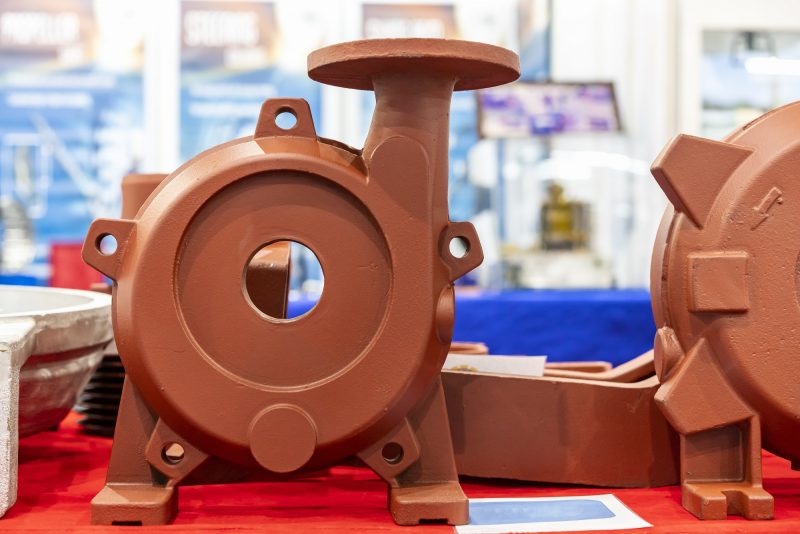Sand Casting vs. Shell Mold Casting
Sand casting is an economical way to produce parts in a variety of metals. Shell mold casting can be an alternative process to consider given specific part design needs. This blog post introduces the shell mold casting process and compares it with sand casting so readers may understand their respective strengths and limitations.

Shell Mold Casting Basics
All casting processes need a pattern for the shape of the part to be cast, and shell molding is no exception. As with sand casting, investment casting and other casting processes, the pattern is used to create the cavity into which liquid metal is poured.
In shell molding a metal pattern tool is coated with a layer of sand. This contains a resin that melts when heated and cools to form a thin shell, (typically 1/4 – 3/8” thick,) around the pattern. Melting is achieved by heating the pattern before coating in sand, then heating the shell to fully cure the resin.
The shell is made in two halves so it can be released from the pattern. After each half shell, (sometimes called a “biscuit”), is lifted away from the pattern the two shells are bonded together, forming the cavity in the space between them. The assembled shell is then placed into a flask where it’s supported with granular material like sand or shot.
The shell is filled with liquid metal which is allowed to cool. Once solid, the shell is taken out of the flask and broken apart to release the cast metal part. A limitation is that while it’s not impossible to add cores to form hollow regions, it is difficult to do.
Two Types of Sand
Shell mold casting uses a different sand to that used in green sand casting, and this is what gives the process its advantages. In sand casting the “green” sand, (green meaning not dried and not the color,) is held together by a binder of clay, usually Bentonite.
The silica sand used for shell molding is finer than that used for sand casting. The American Foundry Society uses a “fineness number” to characterize average grain size where a higher number indicates smaller grains. Green sand is typically 60 – 80 on this scale while shell molding sand is 100 or higher. In addition, rather than using a clay binder, the sand is given a thin coating of phenolic resin which is what melts to form the shell.
Consequences of Fine-Grained Sand
The fine grained sand packs more tightly than green sand, which reduces gas permeability. Sand casting requires a degree of permeability to let moisture, in the form of water vapor, out. This isn’t a problem in shell molding though because the shell is dried and heated before metal pouring.
The major benefits of finer sand are that it conforms more closely to find surface features on the pattern and provides a smoother surface for the metal.
For even better replication of surface detail, and a smoother finish, a foundry may use zircon sand. This can have a fineness number as high as 150. It also has a lower coefficient of thermal expansion which allows application of tighter tolerances.
How Shell Molding Benefits Cast Parts
Superior surface finish and reproduction of fine detail are two of the major strengths of this process. In addition, shell molding requires minimal draft angles to release the pattern from the shell.
Whereas sand casting typically needs 2° – 3° of draft, the shell molding process gets away with 1°, and on short vertical walls it may be possible to have zero. This allows application of smaller machining allowances, which saves time and money in finishing operations.
Sand Casting and Shell Mold Casting Compared
Sand casting:
- Works for ferrous and non-ferrous metals
- Can produce parts weighing from ounces to hundreds of pounds
- Can’t reproduce fine surface detail from the pattern
- Has low geometric precision
- Leaves a rough surface finish
- Requires large machining allowances
- Is an economical process
In comparison, shell molding:
- Works for ferrous and non-ferrous metals
- Is limited to parts weighing less than 30 lbs
- Is unsuited for parts that need cores
- Reproduces fine surface detail
- Can maintain tight tolerances
- Leaves a smooth surface finish
Learn More
In terms of capabilities and costs, shell mold casting falls between sand and investment casting. It’s more complex than sand casting and can produce more complex parts, but without the sophistication and complexity of a wax pattern process.
Impro makes aluminum aerospace parts by shell mold casting when it makes sense. If you’d like to discover whether the process is right for your parts, contact us. Our casting specialists will be happy to help.